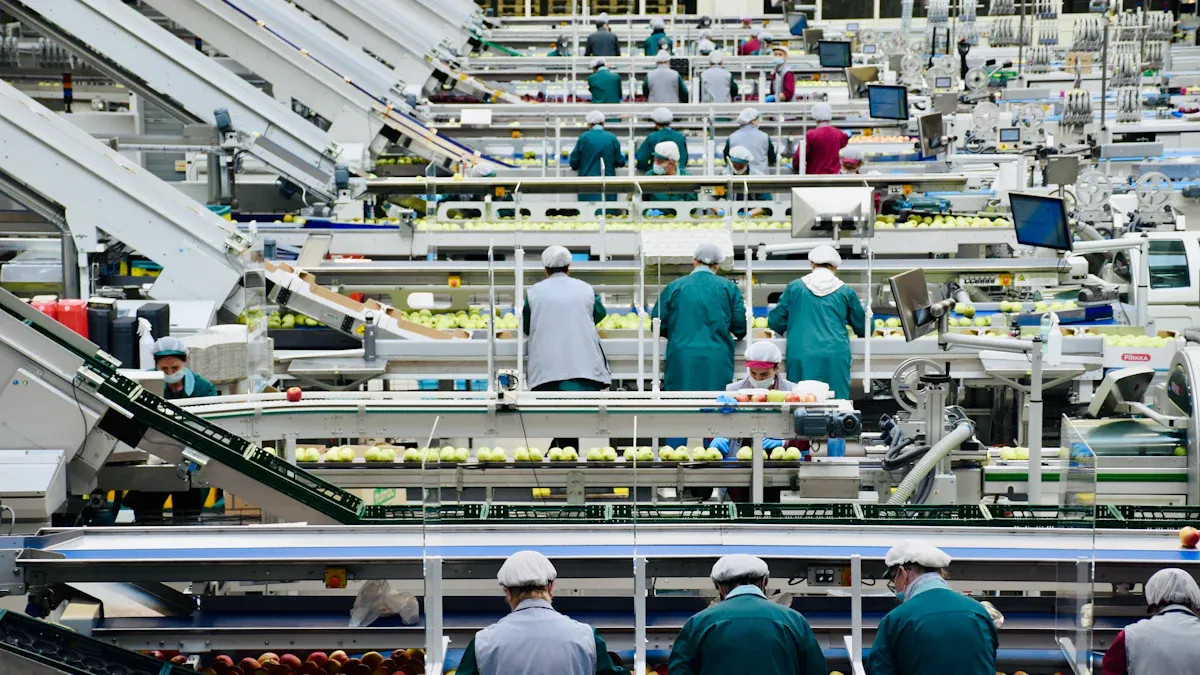
Effizienz in Lebensmittelproduktionslinien ist der Schlüssel zur Erfüllung 2025 Bedürfnisse. Die Lebensmittel- und Getränkemärkte wachsen um 6.2% Jedes Jahr. Fabriken müssen Wege finden, mehr zu produzieren und besser zu arbeiten. Die Verbesserung der Lebensmittelproduktionslinien hilft Kosten senken und Qualität kontrollieren. Es reduziert auch den Abfall, dem Planeten helfen. Der Einsatz schlanker Methoden und neuer Technologien sorgt für einen reibungslosen Ablauf und spart Geld. Unternehmen wie Guanyu bieten maßgeschneiderte Lösungen, um Fabriken dabei zu helfen, sich zu verbessern und in einem schwierigen Markt die Nase vorn zu behalten.
Key Takeaways
1. Schnelle Produktion zur Deckung der Marktnachfrage
Implementierungsschritte und Tool-Empfehlungen:
- Datenanalyse und Prognose:
- Nutzen Sie Tools zur Analyse von Verkaufsdaten und Markttrends (wie Tableau oder Power BI) um die Produktnachfrage vorherzusagen.
- Passen Sie Produktionspläne in Echtzeit basierend auf Prognoseergebnissen und historischen Nachfragemustern an.
- Automatisierung und intelligente Produktion:
- Führen Sie automatisierte Produktionslinien mit speicherprogrammierbaren Steuerungen ein (SPS) zur Überwachung der Produktionsgeschwindigkeit in Echtzeit.
- Integrieren Sie intelligente Planungssysteme, um die Produktionsleistung an Schwankungen der Marktnachfrage anzupassen.
Erfolgsbeispiel:
Eine bekannte Fast-Food-Kette implementierte eine Big-Data-Analyseplattform, die Produktionspläne mit Echtzeit-Verkaufsdaten synchronisierte. Infolge, Die Produktionseffizienz stieg um 20% Gleichzeitig wird die durch ungenaue Nachfrageprognosen verursachte Materialverschwendung reduziert.
2. Vorbeugende Gerätewartung zur Reduzierung von Ausfallzeiten
Implementierungsschritte und Tool-Empfehlungen:
- Routineinspektionsprotokolle:
- Entwickeln und erzwingen Sie wöchentliche und monatliche Wartungschecklisten für jedes Gerät.
- Dokumentieren und verfolgen Sie den Wartungsverlauf mit Computer-Wartungsmanagementsystemen (CMMS).
- Intelligente Überwachungssysteme:
- Setzen Sie IoT-Sensoren ein (Z.B., Temperatur, Vibration, Drucksensoren) zur kontinuierlichen Überwachung des Gerätezustands.
- Richten Sie automatisierte Benachrichtigungen ein, damit Wartungsteams Probleme beheben können, bevor sie zu Ausfällen führen.
Erfolgsbeispiel:
Eine Lebensmittelverarbeitungsanlage integrierte IoT-Sensoren und ein CMMS, was eine frühzeitige Fehlererkennung ermöglichte. Dieser proaktive Ansatz führte zu a 30% Reduzierung der Ausfallzeiten, Reduzierung unerwarteter Reparaturen und Vermeidung kostspieliger Unterbrechungen in der Produktionslinie.
3. Optimiertes Prozessdesign steigert die Effizienz
Implementierungsschritte und Tool-Empfehlungen:
- Optimiertes Workflow-Design:
- Nutzen Sie Prozessflussdiagramm-Tools wie Microsoft Visio oder Lucidchart, um Produktionslinienprozesse abzubilden und zu optimieren.
- Überprüfen und aktualisieren Sie das Layout regelmäßig, um reibungslose Übergänge zwischen den Phasen sicherzustellen.
- Ergonomische Werkzeuge und Spezialausrüstung:
- Investieren Sie in ergonomisch gestaltete Werkzeuge und Vorrichtungen, die auf spezifische Produktionsaufgaben zugeschnitten sind, Reduzierung der Ermüdung der Mitarbeiter und der Fehlerquote.
- Implementieren Sie fahrerlose Transportfahrzeuge (AGVs) für den effizienten Transport von Rohstoffen und Fertigprodukten, Minimierung der manuellen Handhabung.
Erfolgsbeispiel:
Ein mittelständischer Lebensmittelhersteller hat seine Produktionslinie durch die Integration von AGVs und ergonomischen Werkzeugen umstrukturiert. Durch diese Neugestaltung wurde der Produktionszyklus verkürzt 25% bei gleichzeitiger Reduzierung der Arbeitsintensität, was zu deutlichen Effizienzsteigerungen führt.
4. Wassereinsparung und Abfallreduzierung für Umwelt- und Kostenvorteile
Implementierungsschritte und Tool-Empfehlungen:
- Wasserrecyclingsysteme:
- Installieren Sie Wasseraufbereitungs- und Recyclingsysteme, um die Reinheit und Wiederverwendung von Wasser in Produktionsprozessen sicherzustellen.
- Überwachen Sie den Wasserverbrauch mit Echtzeit-Managementsoftware, um Bereiche für weitere Einsparungen zu identifizieren.
- Lebensmittelabfallmanagement:
- Erstellen Sie einen systematischen Ansatz zur Trennung und Wiederverwertung von Produktionsabfällen.
- Entdecken Sie Möglichkeiten zur Wiederverwendung von Lebensmittelabfällen zur Energiegewinnung (Z.B., anaerobe Verdauung) oder Kompostierung.
- Überwachung der Energieeffizienz:
- Implementieren Sie Energiemanagementsysteme (wie EcoStruxure von Schneider Electric) Überwachung und Optimierung des Energieverbrauchs in der gesamten Anlage.
Erfolgsbeispiel:
Eine große Lebensmittelfabrik hat ein umfassendes Wasserspar- und Abfallrecyclingsystem eingeführt. Diese Initiative reduzierte nicht nur die Betriebswasserkosten um 15% sondern sicherte sich auch Umweltzertifizierungen, die den Ruf der Marke stärkten.
5. Verbesserte Mitarbeiterschulung steigert Sicherheit und Qualität
1. Schnelle Produktion zur Deckung der Marktnachfrage
Implementierungsschritte und Tool-Empfehlungen:
- Datenanalyse und Prognose:
- Nutzen Sie Tools zur Analyse von Verkaufsdaten und Markttrends (wie Tableau oder Power BI) um die Produktnachfrage vorherzusagen.
- Passen Sie Produktionspläne in Echtzeit basierend auf Prognoseergebnissen und historischen Nachfragemustern an.
- Automatisierung und intelligente Produktion:
- Führen Sie automatisierte Produktionslinien mit speicherprogrammierbaren Steuerungen ein (SPS) zur Überwachung der Produktionsgeschwindigkeit in Echtzeit.
- Integrieren Sie intelligente Planungssysteme, um die Produktionsleistung an Schwankungen der Marktnachfrage anzupassen.
Erfolgsbeispiel:
Eine bekannte Fast-Food-Kette implementierte eine Big-Data-Analyseplattform, die Produktionspläne mit Echtzeit-Verkaufsdaten synchronisierte. Infolge, Die Produktionseffizienz stieg um 20% Gleichzeitig wird die durch ungenaue Nachfrageprognosen verursachte Materialverschwendung reduziert.
2. Vorbeugende Gerätewartung zur Reduzierung von Ausfallzeiten
Implementierungsschritte und Tool-Empfehlungen:
- Routineinspektionsprotokolle:
- Entwickeln und erzwingen Sie wöchentliche und monatliche Wartungschecklisten für jedes Gerät.
- Dokumentieren und verfolgen Sie den Wartungsverlauf mit Computer-Wartungsmanagementsystemen (CMMS).
- Intelligente Überwachungssysteme:
- Setzen Sie IoT-Sensoren ein (Z.B., Temperatur, Vibration, Drucksensoren) zur kontinuierlichen Überwachung des Gerätezustands.
- Richten Sie automatisierte Benachrichtigungen ein, damit Wartungsteams Probleme beheben können, bevor sie zu Ausfällen führen.
Erfolgsbeispiel:
Eine Lebensmittelverarbeitungsanlage integrierte IoT-Sensoren und ein CMMS, was eine frühzeitige Fehlererkennung ermöglichte. Dieser proaktive Ansatz führte zu a 30% Reduzierung der Ausfallzeiten, Reduzierung unerwarteter Reparaturen und Vermeidung kostspieliger Unterbrechungen in der Produktionslinie.
3. Optimiertes Prozessdesign steigert die Effizienz
Implementierungsschritte und Tool-Empfehlungen:
- Optimiertes Workflow-Design:
- Nutzen Sie Prozessflussdiagramm-Tools wie Microsoft Visio oder Lucidchart, um Produktionslinienprozesse abzubilden und zu optimieren.
- Überprüfen und aktualisieren Sie das Layout regelmäßig, um reibungslose Übergänge zwischen den Phasen sicherzustellen.
- Ergonomische Werkzeuge und Spezialausrüstung:
- Investieren Sie in ergonomisch gestaltete Werkzeuge und Vorrichtungen, die auf spezifische Produktionsaufgaben zugeschnitten sind, Reduzierung der Ermüdung der Mitarbeiter und der Fehlerquote.
- Implementieren Sie fahrerlose Transportfahrzeuge (AGVs) für den effizienten Transport von Rohstoffen und Fertigprodukten, Minimierung der manuellen Handhabung.
Erfolgsbeispiel:
Ein mittelständischer Lebensmittelhersteller hat seine Produktionslinie durch die Integration von AGVs und ergonomischen Werkzeugen umstrukturiert. Durch diese Neugestaltung wurde der Produktionszyklus verkürzt 25% bei gleichzeitiger Reduzierung der Arbeitsintensität, was zu deutlichen Effizienzsteigerungen führt.
4. Wassereinsparung und Abfallreduzierung für Umwelt- und Kostenvorteile
Implementierungsschritte und Tool-Empfehlungen:
- Wasserrecyclingsysteme:
- Installieren Sie Wasseraufbereitungs- und Recyclingsysteme, um die Reinheit und Wiederverwendung von Wasser in Produktionsprozessen sicherzustellen.
- Überwachen Sie den Wasserverbrauch mit Echtzeit-Managementsoftware, um Bereiche für weitere Einsparungen zu identifizieren.
- Lebensmittelabfallmanagement:
- Erstellen Sie einen systematischen Ansatz zur Trennung und Wiederverwertung von Produktionsabfällen.
- Entdecken Sie Möglichkeiten zur Wiederverwendung von Lebensmittelabfällen zur Energiegewinnung (Z.B., anaerobe Verdauung) oder Kompostierung.
- Überwachung der Energieeffizienz:
- Implementieren Sie Energiemanagementsysteme (wie EcoStruxure von Schneider Electric) Überwachung und Optimierung des Energieverbrauchs in der gesamten Anlage.
Erfolgsbeispiel:
Eine große Lebensmittelfabrik hat ein umfassendes Wasserspar- und Abfallrecyclingsystem eingeführt. Diese Initiative reduzierte nicht nur die Betriebswasserkosten um 15% sondern sicherte sich auch Umweltzertifizierungen, die den Ruf der Marke stärkten.
5. Verbesserte Mitarbeiterschulung steigert Sicherheit und Qualität
Implementierungsschritte und Tool-Empfehlungen:
Richten Sie einen Echtzeit-Feedbackmechanismus für Mitarbeiter ein, um Herausforderungen zu melden und Verbesserungen vorzuschlagen.
Regelmäßige Schulungen und Beurteilungen:
Entwickeln Sie detaillierte Schulungsprogramme für neue Tools, Technologien, und Sicherheitsprotokolle.
Führen Sie regelmäßige Bewertungen durch, um sicherzustellen, dass die Mitarbeiter mit der Verwendung aktualisierter Geräte und Methoden vertraut sind.
Online-Lernplattformen:
Richten Sie einen internen Online-Schulungshub mit Video-Tutorials ein, Simulationsübungen, und aktuelle Ressourcen für kontinuierliches Lernen.
Nutzen Sie interaktive E-Learning-Module, um praktische virtuelle Erfahrungen zu ermöglichen.
Praxisnahe Schulungen und Feedbackschleifen vor Ort:
Kombinieren Sie Präsenzschulungen mit Übungen vor Ort, um neue Fähigkeiten zu festigen.
Komponenten und Prozesse einer Lebensmittelproduktionslinie.
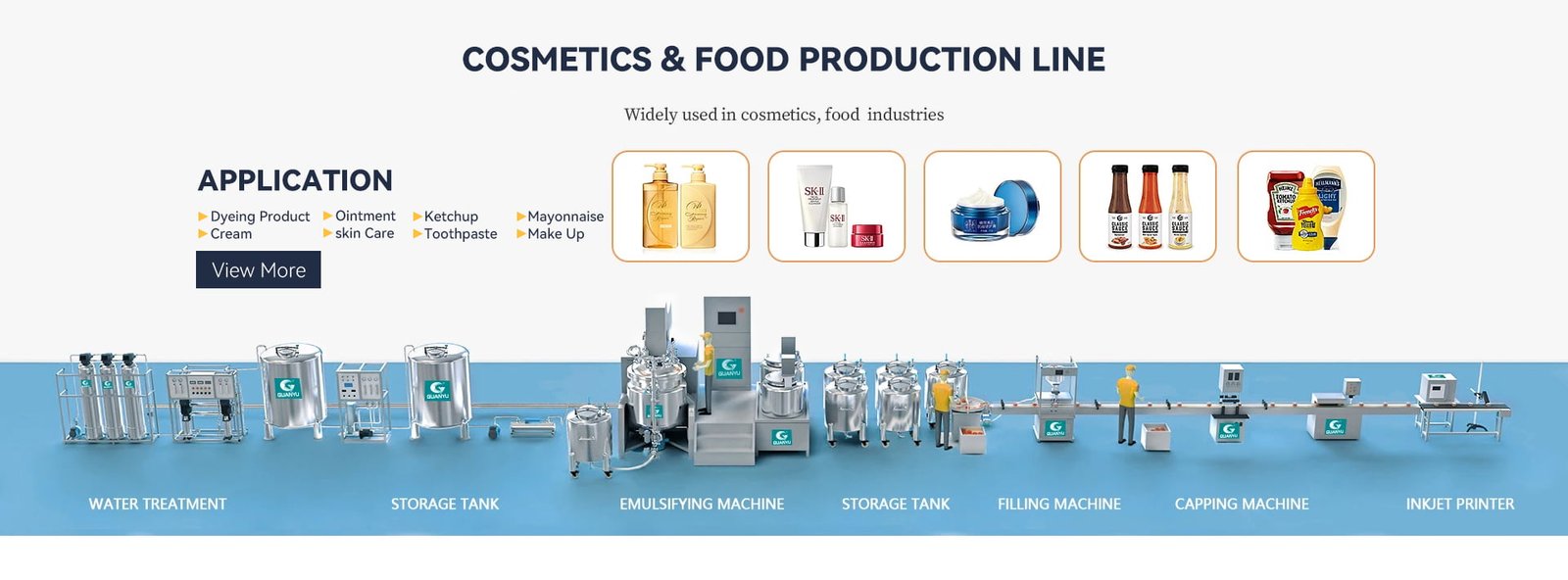
Wasserversorgung: Wasser von Anfang an sauber halten
Wasser wird in vielen Lebensmitteln verwendet. Sauberes Wasser ist wichtig für sichere und qualitativ hochwertige Lebensmittel. Eine gute Wasseraufbereitung verhindert Probleme wie Verunreinigungen oder Rückrufe. Dies kann durch die Festlegung von Wasserregeln und die Verwendung besserer Reinigungswerkzeuge erreicht werden. Zum Beispiel:
Schmutziges Wasser kann die Nahrung ruinieren und die Produktion verlangsamen.
Durch die Überprüfung des Wassers wird häufig die Sicherheit gewährleistet und die Regeln eingehalten.
In Branchen wie der Medizin, Strenge Regeln wie USP sorgen für sauberes Wasser. Diese Regeln helfen Fabriken, sicher zu bleiben und Probleme zu vermeiden. Durch den Einsatz guter Wassersysteme, Sie können Ihre Lebensmittelproduktion schneller und sicherer gestalten.
Lagertanks: Sichere Orte für Lebensmittel und Zutaten
Lagertanks halten Lebensmittel und Zutaten frisch und sicher. Durch die Einhaltung sauberer Regeln funktionieren Lagertanks besser. Zu den guten Gewohnheiten gehört:
Best Practice | Was es bedeutet |
|---|---|
Lebensmittelrotation | Verwenden Sie zuerst alte Gegenstände, um Abfall zu vermeiden. |
Temperaturregelung | Halten Sie die Tanks zwischen 50 °F und 70 °F, um ein Verderben zu vermeiden. |
Feuchtigkeitsmanagement | Luft trocken halten (unten 15%) um Schimmel zu stoppen. |
Sonnenlichtprävention | Halten Sie Lebensmittel von Sonnenlicht fern, um Nährstoffe zu sparen. |
Lagerung zur Risikoreduzierung | Bewahren Sie Lebensmittel zur leichteren Reinigung nicht auf dem Boden und in der Nähe von Wänden auf. |
Schädlingsbekämpfung | Lücken schließen und reinigen, um Schädlinge fernzuhalten. |
Mit diesen Tipps bleiben Lagertanks sauber und die Lebensmittelproduktion läuft reibungslos.
Emulgiermaschine: Zutaten perfekt vermischen
Emulgiermaschinen vermischen die Zutaten glatt, sogar Mischungen. Diese Maschinen sorgen dafür, dass Lebensmittel jedes Mal gleich aussehen und gleich schmecken. Wichtige Dinge, die überprüft werden müssen, sind::
Metrisch | Was es prüft |
|---|---|
Überprüft, ob die Mischung im Laufe der Zeit glatt bleibt. | |
Pannenmechanismen | Findet Probleme wie Trennung oder Verklumpung in der Mischung. |
Besondere Merkmale, wie Vakuumsysteme, Stoppen Sie Luftblasen und sorgen Sie für bessere Mischungen. Diese Maschinen werden in der Lebensmittelindustrie eingesetzt, Medizin, und Schönheitsprodukte. Verwendung gute Emulgiermaschinen hilft Ihnen, Mischungen zu kontrollieren und die Lebensmittelproduktion zu verbessern.
Abfüllmaschine: Präzise und effiziente Produktabgabe
Abfüllmaschinen tragen dazu bei, die Lebensmittelproduktion schneller und präziser zu gestalten. Sie füllen die richtige Produktmenge in Behälter, Abfall reduzieren und die Dinge konsistent halten. Mit smarten Funktionen, Diese Maschinen verbessern die Funktionsweise von Fabriken.
Hauptmerkmale moderner Abfüllmaschinen sind:
Kolbenmechanismus: Misst und füllt Flüssigkeiten ab, Vergangenheit, oder Pulver genau.
Automatische Umstellungen: Wechselt schnell zwischen Produkten und Behältergrößen.
Niveaukontrollsysteme: Verhindert Über- oder Unterfüllung, indem der Füllstand konstant gehalten wird.
Datenintegration: Verfolgt und verwaltet den Abfüllprozess in Echtzeit.
Automatisierte Reinigungssysteme: Erleichtert die Reinigung und verringert das Kontaminationsrisiko.
Besonderheit | Was es tut |
|---|---|
Kolbenmechanismus | Füllt Behälter mit der genauen Produktmenge. |
Automatische Umstellungen | Schneller Wechsel zwischen Produkten und Behältern, Zeitersparnis. |
Niveaukontrollsysteme | Hält den Produktstand konstant, um Füllfehler zu vermeiden. |
Datenintegration | Beobachten und steuern Sie den Prozess live, um bessere Ergebnisse zu erzielen. |
Automatisierte Reinigungssysteme | Vereinfacht die Reinigung und sorgt für hygienischen Betrieb. |
Diese Maschinen schonen Ressourcen und ermöglichen Flexibilität. Sie handhaben unterschiedliche Produkte und Behälter, Produktionslinien fit für neue Anforderungen machen.
Verschließmaschine: Sicherung der Produktintegrität
Verschließmaschinen halten Produkte während der Lagerung und des Versands versiegelt und sicher. Sie tragen dazu bei, die Qualität aufrechtzuerhalten und Vertrauen bei den Kunden aufzubauen. Regelmäßige Pflege und richtige Einrichtung sind der Schlüssel für gute Ergebnisse.
Zur Verbesserung der Deckelung, Konzentrieren Sie sich auf diese Punkte:
Wählen Sie die richtige Verschließmaschine für Ihr Produkt und Ihre Verpackung.
Befolgen Sie einen Wartungsplan, damit die Maschinen einwandfrei funktionieren.
Nutzen Sie Daten, um die Leistung zu überprüfen und die Qualität sicherzustellen.
Schlüsselaspekt | Was es bedeutet |
|---|---|
Auswahl der Ausrüstung | Die Wahl der richtigen Maschine sorgt für Effizienz und Produktsicherheit. |
Regelmäßige Wartung | Maschinen in gutem Zustand zu halten stellt sicher, dass sie zuverlässig funktionieren. |
Datenanalyse zur Qualitätskontrolle | Die Verwendung von Daten hilft dabei, die Leistung zu verfolgen und hohe Standards aufrechtzuerhalten. |
Indem Sie diese Tipps befolgen, Sie können das Verschließen effizienter gestalten und höchste Qualitätsstandards erfüllen.
Tintenstrahldrucker: Chargencodierung und Produktrückverfolgbarkeit
Tintenstrahldrucker werden zur Chargencodierung und Nachverfolgung von Produkten verwendet. Sie drucken eindeutige Codes auf Artikel, Helfen Sie dabei, Regeln einzuhalten und die Nachverfolgung der Lieferkette zu verbessern. Neue Drucktechnologien machen sie präziser und effizienter.
Der Markt für Tintenstrahldrucker wächst schnell. In 2023, es hat sich gelohnt $3.1 Milliarde und erreichen konnte $5.2 Milliarden von 2032, Anbau 5.6% jährlich. Dieses Wachstum ist auf die Notwendigkeit einer besseren Nachverfolgung und strengerer Regeln zurückzuführen.
Marktgröße (2023) | Projizierte Größe (2032) | Wachstumsrate (%) | Warum es wächst |
|---|---|---|---|
$3.1 Milliarde | $5.2 Milliarde | 5.6 | Nachfrage nach Tracking, bessere Technik, und strenge Regeln |
Durch den Einsatz fortschrittlicher Tintenstrahldrucker, Sie können die Produktsicherheit verbessern und die Kundenbedürfnisse erfüllen. Diese Drucker schützen auch Marken, indem sie transparent drucken, genaue Codes auf jedem Artikel.
Neue Technologien für die Effizienz der Lebensmittelproduktion
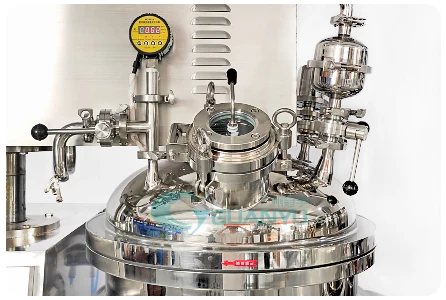
Industrie 4.0 und seine Rolle in der Lebensmittelproduktionslinie
Industrie 4.0 verändert die Arbeitsweise von Lebensmittelfabriken. Es verwendet intelligente Werkzeuge um die Produktion schneller und günstiger zu machen. Roboter, Automatisierung, und Datensysteme tragen zur Effizienzsteigerung bei. Maschinen können sich wiederholende Aufgaben erledigen, So können sich die Mitarbeiter auf Qualität und neue Ideen konzentrieren.
Industrie 4.0 verbessert viele Bereiche der Lebensmittelproduktion:
Leistungsmetrik | Was es bedeutet |
|---|---|
Bessere Kontrolle der Prozesse für reibungslosere Abläufe. | |
Durchlaufzeit | Schnellere Produktionszyklen sparen Zeit. |
Reduzierung der Vorlaufzeit | Schnellere Lieferung von Produkten an Kunden. |
Betriebskosten | Geringere Kosten durch intelligente Maschinen und Anlagen. |
Qualitäts- und Sicherheitsmaßnahmen | Sauberere und sicherere Lebensmittel durch automatisierte Kontrollen. |
Produktivität und betriebliche Effizienz | Mehr Leistung und bessere Ressourcennutzung. |
Abfallreduzierung | Weniger Abfall und Energieverbrauch, der Umwelt helfen. |
Nachfrageprognose | Vorhersage der Kundenbedürfnisse entsprechend dem Produktionsniveau. |
Industrie nutzen 4.0 Werkzeuge helfen Fabriken, besser zu arbeiten, weniger verschwenden, und machen Sie mehr, während Sie gleichzeitig die Lebensmittelqualität hoch halten.
IIoT: Echtzeitüberwachung für bessere Kontrolle
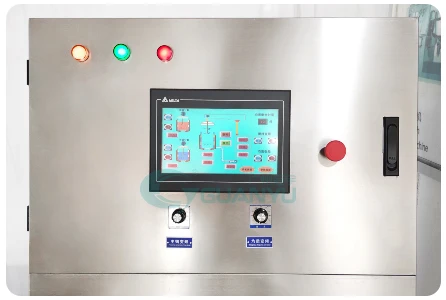
Das industrielle Internet der Dinge (IIoT) verbindet Maschinen und Anlagen. Damit können Fabriken die Produktion in Echtzeit überwachen und steuern. Sensoren prüfen Dinge wie die Temperatur, Luftfeuchtigkeit, und Lagerbestände. Diese Tools liefern nützliche Informationen zur Verbesserung der Produktion.
IIoT kann vor Problemen in der Lieferkette warnen, dafür zu sorgen, dass alles reibungslos läuft. Außerdem wird vorhergesagt, wann Maschinen repariert werden müssen, Ausfallzeiten reduzieren. Der Einsatz von IIoT beschleunigt die Lebensmittelproduktion und sorgt für eine gleichbleibende Qualität.
KI und maschinelles Lernen: Intelligentere Lebensmittelproduktion
Künstliche Intelligenz (KI) und maschinelles Lernen (Ml) Helfen Sie Fabriken, besser zu planen. Sie untersuchen Daten, um Muster zu finden und zukünftige Bedürfnisse vorherzusagen. Dies hilft Fabriken, die Produktion an die Nachfrage anzupassen.
KI-Tools reduzieren Verschwendung und sparen Geld, indem sie Ressourcen sinnvoll nutzen. Zum Beispiel, Sie können Maschinenprobleme frühzeitig erkennen, So erfolgen Reparaturen vor Pannen. So läuft die Produktion reibungslos weiter.
Durch die Einbindung von KI und ML in die Lebensmittelproduktion werden Effizienz und Qualität verbessert. Diese Tools helfen Fabriken, wettbewerbsfähig zu bleiben und großartige Produkte zu liefern.
Optimierung von Ausrüstung und Layout in Lebensmittelproduktionslinien
Maßgeschneiderte Ausrüstung für spezifische Anforderungen
Spezielle Maschinen lösen einzigartige Probleme in Lebensmittelfabriken. Benutzerdefinierte Werkzeuge helfen Maschinen, für bestimmte Aufgaben besser zu arbeiten. Die Integration von KI und IoT in Maschinen verbessert die Kontrolle und Qualität. Dadurch wird die Arbeit beschleunigt und die Kundenbedürfnisse erfüllt.
Unternehmen wie DC Norris North America stellen Werkzeuge auf Basis der Losgröße her, Kochzeit, und Verpackung. Dieses individuelle Design erleichtert und beschleunigt die Arbeit. Immer mehr Fabriken benötigen Spezialwerkzeuge wie Doppelschneckenextruder. Werkzeughersteller arbeiten hart daran, bessere Maschinen für sich ändernde Anforderungen zu entwickeln.
Wichtigste Erkenntnisse | Details |
|---|---|
Erhöhte Investitionen | |
Neue Werkzeuge werden für spezifische Fabrikanforderungen hergestellt. | |
Nachfrage nach technischen Produkten | Spezialwerkzeuge wie Extruder erfreuen sich immer größerer Beliebtheit. |
Intelligente Layouts zur Reduzierung von Verzögerungen
Gute Fabriklayouts verkürzen Verzögerungen und halten die Arbeit am Laufen. Durch die intelligente Platzierung von Maschinen können Teams besser zusammenarbeiten. Das vermeidet Probleme und sorgt für einen reibungslosen Ablauf.
Intelligente Layouts sparen außerdem Geld und erhöhen die Sicherheit. Zum Beispiel, Ein besserer Materialfluss stoppt Verlangsamungen. Ein klares Layout hilft dabei, den Arbeitsbereich zu organisieren und Ziele schneller und mit weniger Abfall zu erreichen.
Aktualisieren alter Systeme für bessere Ergebnisse
Alte Maschinen können die Arbeit verlangsamen und die Reparatur kostet mehr. Ihre Aufrüstung beschleunigt die Arbeit und erfüllt neue Regeln. Neue Maschinen sind sicherer, einfacher zu aktualisieren, und funktionieren gut mit modernen Werkzeugen.
Studien zeigen 74% der Fabriken haben Probleme mit alten Systemen. Upgrades können funktionieren 33% schneller und senken die Kosten um 25% in einem Jahr. Neue Tools prognostizieren außerdem Probleme und beheben sie frühzeitig. Das spart Geld und sorgt dafür, dass die Lebensmittelproduktion reibungslos läuft.
Abfallreduzierung und Nachhaltigkeit in der Lebensmittelherstellung
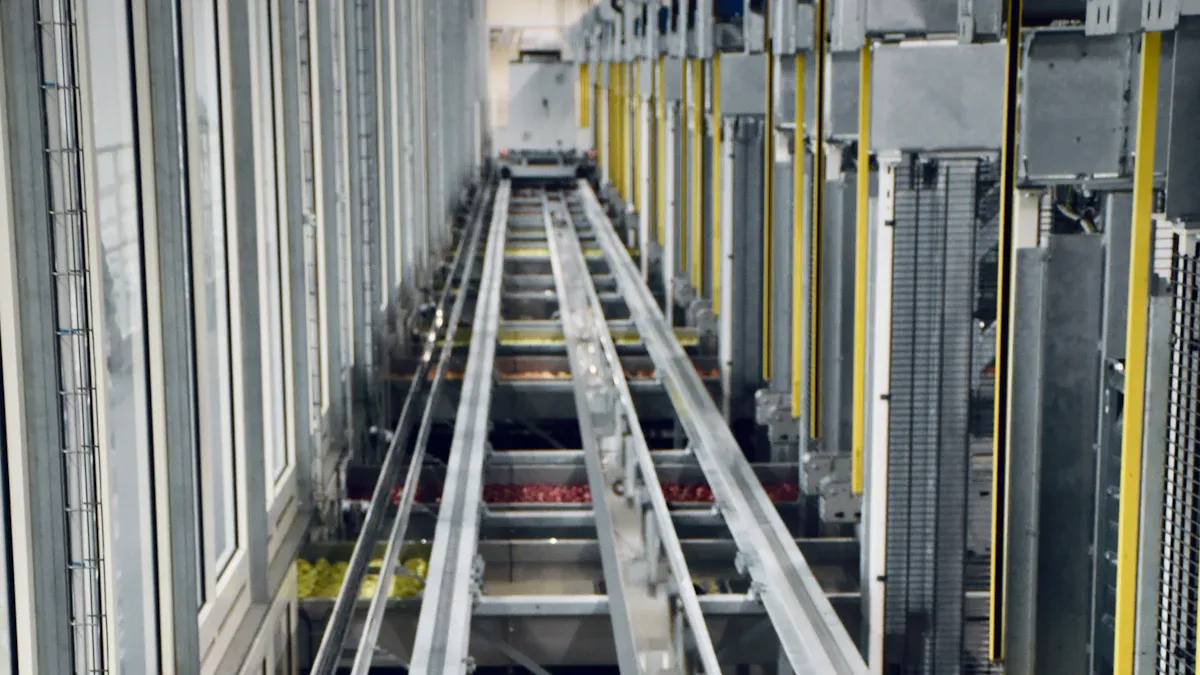
Wasser sparen, um der Umwelt zu helfen
Wassersparen ist wichtig für eine bessere Produktion und Nachhaltigkeit. Durch den geringeren Wasserverbrauch wird der Energieverbrauch gesenkt und die Umweltverschmutzung verringert. Das hilft der Natur und sorgt dafür, dass Wasser für die Nahrungsproduktion verfügbar bleibt.
Wassereinsparungen helfen landwirtschaftlichen Betrieben, in Trockenzeiten Nahrungsmittel anzubauen.
Es unterstützt Gebiete mit wenig Wasser, Aufrechterhaltung von Bauernhöfen und Arbeitsplätzen.
Durch den geringeren Wasserverbrauch werden Verlangsamungen aufgrund von Engpässen vermieden.
Der Einsatz intelligenter Tools wie bessere Reinigungssysteme und Wasserrecycling kann die Fabrikarbeit verbessern. Diese Methoden sparen Geld und schonen die Umwelt für die Zukunft.
Reduzierung der Lebensmittelverschwendung durch bessere Lagerverwaltung
Lebensmittelverschwendung ist in Fabriken ein großes Problem. Eine kluge Bestandsverwaltung kann dieses Problem beheben. Die Echtzeitverfolgung zeigt an, wie viel Lagerbestand Sie haben, und verhindert Überproduktion. Das spart Ressourcen und reduziert Abfall.
Verwendung von First-In, First-out (FIFO) Regeln helfen dabei, ältere Elemente zuerst zu verwenden. Dies verhindert den Verderb und hält die Produkte für die Kunden frisch. Vorhersagetools können die Nachfrage einschätzen, So produzieren Sie gerade genug und vermeiden Abfall.
Die Reduzierung von Lebensmittelabfällen macht Fabriken effizienter und zeigt den Kunden, dass Ihnen der Planet am Herzen liegt.
Abfall in nützliche Ressourcen verwandeln
Durch die Wiederverwertung von Abfällen kann daraus etwas Wertvolles werden. Dies unterstützt ein System, in dem Materialien wiederverwendet statt weggeworfen werden. Zum Beispiel, Lebensmittelabfälle können zu Kompost oder Kraftstoff werden, was der Umwelt hilft.
Quelle | Was es sagt |
|---|---|
Spricht über Wiederverwendung und Recycling, um Abfall in Lebensmittelfabriken zu reduzieren. | |
Den Kreislauf schließen: Wie Kreislaufwirtschaftsansätze Lebensmittelverschwendung bekämpfen und Nachhaltigkeit fördern können | Erklärt die Kompostierung und die Herstellung von Kraftstoff aus Lebensmittelabfällen, um dem Planeten zu helfen. |
Kreislaufwirtschaft in der Lebensmittelkette: Produktion, Verarbeitung und Abfallmanagement | Konzentriert sich auf das Recycling von Nährstoffen und Nebenprodukten, um Abfall zu reduzieren. |
Durch Recycling und Wiederverwendung, Fabriken können Probleme aufgrund von Ressourcenknappheit vermeiden. Dies hilft auch dem Planeten und verbessert die Produktion.
Wartung und Überwachung für Produktionseffizienz
Vorausschauende Wartung zur Vermeidung von Ausfallzeiten
Durch vorausschauende Wartung wird verhindert, dass Maschinen unerwartet ausfallen. Es nutzt Daten und intelligente Tools, um den Maschinenzustand zu überprüfen. Sensoren und Programme sagen voraus, wann eine Maschine möglicherweise nicht mehr funktioniert. Durch die frühzeitige Behebung von Problemen wird ein Produktionsstopp vermieden.
Vorhersagewartung kann Reduzieren Sie die Ausbrüche durch 70% und speichern 25% auf Reparaturen, sagt Deloitte.
Sensoren senden Live-Updates über Maschinen, Helfen Sie den Arbeitnehmern, schnell zu handeln.
Datentools erkennen Probleme frühzeitig, die Produktion reibungslos und effizient zu halten.
Der Einsatz von Predictive Maintenance spart Zeit, senkt die Kosten, und sorgt dafür, dass die Maschinen gut laufen.
Echtzeit-Datenverfolgung für proaktive Entscheidungsfindung
Echtzeit-Tracking zeigt Live-Updates zu Ihrem Produktionsprozess. Dies hilft Ihnen, in einer geschäftigen Lebensmittelfabrik schnelle Entscheidungen zu treffen.
Zu den Vorteilen der Echtzeitverfolgung gehören::
Probleme schnell erkennen um größere Verzögerungen zu vermeiden.
Treffen Sie kluge Entscheidungen, um Pläne und Ressourcen schnell anzupassen.
Steigern Sie die Geräteleistung durch Beheben von Verlangsamungen.
Anpassung an Marktbedürfnisse, um Kundenanforderungen zu erfüllen.
Zum Beispiel, Die Überprüfung wichtiger Leistungszahlen hilft, Probleme zu finden und zu beheben. Echtzeit-Tracking hilft Ihnen, bereit zu bleiben und hohe Standards einzuhalten.
Mit digitalen Zwillingen Prozesse simulieren und optimieren
Digitale Zwillinge sind Computermodelle Ihrer Produktionssysteme. Sie ermöglichen es Ihnen, Ideen zu testen, ohne die eigentliche Arbeit zu unterbrechen. Indem Sie verschiedene Setups ausprobieren, Sie können Möglichkeiten finden, Zeit und Geld zu sparen.
Diese Modelle helfen Ihnen:
Sehen Sie, wie sich Änderungen auf die Produktion auswirken, bevor Sie sie ausprobieren.
Testen Sie neue Layouts oder Tools, um kostspielige Fehler zu vermeiden.
Beobachten und verbessern Sie Prozesse live, um bessere Ergebnisse zu erzielen.
Digitale Zwillinge eignen sich hervorragend dafür Verbesserung der Produktion und in der Lebensmittelherstellung an der Spitze zu bleiben.
Schulung und Sicherheit der Belegschaft in Lebensmittelproduktionslinien
Arbeitnehmer über neue Technologien unterrichten
Die Schulung der Mitarbeiter zu neuen Werkzeugen ist sehr wichtig. Moderne Tools wie KI und IoT machen die Lebensmittelproduktion schneller und sicherer. Aber, Die Arbeitnehmer müssen wissen, wie sie sie gut nutzen können.
Wenn Arbeiter diese Werkzeuge erlernen, Sie können Probleme frühzeitig erkennen. Dies sorgt für die Sicherheit der Produkte und verbessert die Arbeitsgeschwindigkeit. Studien zeigen KI hilft dabei, bessere Produkte herzustellen und Risiken frühzeitig erkennen. Die Schulung von Mitarbeitern ist eine clevere Möglichkeit, Ihre Fabrik zu verbessern.
Um das Training besser zu machen:
Nutzen Sie Übungsstunden, um neue Systeme zu erlernen.
Bieten Sie Hilfe an, wenn Arbeitnehmer Probleme haben.
Lassen Sie die Mitarbeiter Ideen und Tipps untereinander austauschen.
Festlegung von Sicherheitsregeln für Arbeitnehmer und Produkte
Sicherheitsvorschriften sorgen für die Sicherheit der Arbeitnehmer und die Qualität der Produkte. Die Lebensmittelindustrie verwendet strenge Regeln wie HACCP, um Gefahren zu stoppen. Diese Regeln stellen sicher, dass jeder Schritt sicher ist.
Proof-Typ | Was es bedeutet |
|---|---|
Sicherheitsregeln | Sorgen Sie für die Sicherheit der Mitarbeiter und für gute Produkte. |
HACCP-Regeln | Finden Sie Gefahren und legen Sie Sicherheitsmaßnahmen für Lebensmittel fest. |
Arbeiterschulung | Bringen Sie Ihren Mitarbeitern bei, welche Rolle sie bei der Aufrechterhaltung von Sicherheit und hoher Qualität spielen. |
Die Menschen wollen Sicherheit, gutes Essen. Sie vertrauen darauf, dass die Fabriken die Sicherheitsvorschriften einhalten. Die Schulung der Mitarbeiter zum Thema Sicherheit schafft Vertrauen und senkt Risiken in der Produktion.
Unterstützen Sie Lernen und neue Ideen
Durch die Förderung von Lernen und neuen Ideen bleiben die Mitarbeiter zufrieden und qualifiziert. Wenn Arbeitnehmer Neues lernen, Sie bleiben aufgeregt und bereit für Veränderungen. Dies trägt auch dazu bei, dass die Mitarbeiter länger im Unternehmen bleiben und die Arbeit mehr Spaß macht.
Lernen hilft Arbeitnehmern, zu wachsen und sich zu verbessern.
Mitarbeiter, die Ideen teilen, sind stolz und engagiert.
Unterhaltsame Trainingsmethoden, wie bei Airbnb, Verbesserter Aufenthalt der Arbeitnehmer 35%.
Indem wir uns auf das Lernen konzentrieren, Sie helfen Ihrem Team, intelligenter zu arbeiten und neue Ideen in die Lebensmittelproduktion einzubringen.
Kontinuierliche Verbesserung der Effizienz der Lebensmittelproduktion
Mithilfe der Datenanalyse bessere Wege finden
Die Datenanalyse trägt dazu bei, die Arbeitsweise von Lebensmittelfabriken zu verbessern. Durch das Studium von Produktionsdaten, Sie können Probleme finden und beheben. Einige hilfreiche Methoden sind::
Verfahren | Was es tut |
|---|---|
Statistische Prozesskontrolle | Verfolgt Prozessänderungen mit Diagrammen. Es erkennt Probleme frühzeitig und hilft, sie schnell zu beheben. |
Six Sigma | Verwendet Teams und Statistiken, um Probleme zu reduzieren und die Leistung zu steigern. |
Lean Manufacturing | Reduziert Verschwendung, indem Schritte entfernt werden, die keinen Mehrwert bieten. |
Neue Tools helfen auch bei der Datenanalyse. Diese Werkzeuge überwachen Produktionslinien, Studiendaten, und Dinge schnell anpassen. Sie finden langsame Stellen, Lebensmittel retten, und die Arbeit schneller machen. Der Einsatz dieser Tools trägt dazu bei, dass Fabriken immer besser arbeiten.
Mit Feedback Schritt für Schritt verbessern
Feedback ist der Schlüssel zur Verbesserung der Lebensmittelproduktion. Es hilft, Ideen zu testen, Ergebnisse überprüfen, und Prozesse verbessern. Beginnen Sie mit der Datenerfassung in Ihrer Fabrik. Verwenden Sie es, um herauszufinden, was repariert werden muss. Nehmen Sie Änderungen vor und sehen Sie, wie sie funktionieren.
Zum Beispiel, wenn eine Maschine die Dinge verlangsamt, seine Einstellungen ändern oder Arbeiter verschieben. Nachdem ich das versucht habe, Überprüfen Sie, ob es geholfen hat. Wiederholen Sie diesen Vorgang immer wieder, um für neue Herausforderungen gerüstet zu sein.
Der Einsatz von Feedbackschleifen hilft Fabriken, effizient zu bleiben und hohe Standards zu erfüllen.
Zusammenarbeit mit Experten wie Guanyu für maßgeschneiderte Lösungen
Die Zusammenarbeit mit Experten kann Verbesserungen beschleunigen. Guanyu stellt Spezialmaschinen her, um Fabrikprobleme zu lösen. Ihre Tools sind so konzipiert, dass sie Ihren Anforderungen entsprechen und die Effizienz verbessern.
Guanyus Maschinen, wie Mischer und Füllstoffe, Machen Sie die Produktion schneller und halten Sie die Qualität hoch. Mit vorbei 35 jahrelange Erfahrung, Sie bieten zuverlässige Lösungen für schwierige Märkte.
Die Zusammenarbeit mit Experten wie Guanyu trägt dazu bei, dass Ihre Fabrik reibungslos läuft und in der Branche an der Spitze bleibt.
Um die Lebensmittelproduktion zu verbessern, sind intelligente Werkzeuge erforderlich, weniger Abfall, und ausgebildete Arbeitskräfte. Coole Tools wie Vorhersagemodelle und Qualitätsdiagramme helfen dabei, besser zu planen und Fehler zu vermeiden. Diese Ideen machen die Arbeit schneller und sparen Geld, wie unten gezeigt:
Planen | Wobei es hilft |
|---|---|
Intelligente Datenprüfungen | Reduziert die Prüfkosten |
Aus Daten lernen | Ermöglicht eine schnellere Anpassung der Fabriken |
Vorhersagemodelle | Hilft bei der Planung und Organisation der Arbeit |
Qualitätsdiagramme | Stoppt Fehler und behebt Probleme frühzeitig |
Multi-Daten-Studie | Findet verborgene Verbesserungsmöglichkeiten |
Verbesserung | Wie viel besser es wird |
|---|---|
Weniger Fehler in Produkten | |
Weniger Zeit für die Reparatur kaputter Maschinen | 20-35% |
Schnellere Produktion | 5-15% |
Geringere Prüfkosten | 10-25% |
Schnellere Einführung neuer Produkte | Besseres Verständnis der Prozesse |
Wenn Sie stets Verbesserungsmöglichkeiten finden, bleibt Ihre Fabrik stark. Durch die Zusammenarbeit mit Experten wie Guanyu erhalten Sie spezielle Werkzeuge für Ihre Bedürfnisse. Beginnen Sie jetzt damit, Ihre Fabrik zum Besten zu machen 2025!
FAQ
Wie können Lebensmittelfabriken schneller und besser arbeiten??
Verwendung intelligente Werkzeuge wie ein, IoT, und vorausschauende Wartung hilft. Diese Tools machen Prozesse reibungsloser, Ausfallzeiten verkürzen, und die Produktqualität verbessern. Maßgeschneiderte Maschinen und intelligente Layouts machen Fabriken zudem effizienter.
Welchen Nutzen hat die vorausschauende Wartung für Lebensmittelfabriken??
Durch vorausschauende Wartung werden Maschinenprobleme erkannt, bevor sie auftreten. Es verhindert plötzliche Ausfälle, senkt die Reparaturkosten, und hält die Produktion reibungslos läuft. Dies hilft Fabriken, Verzögerungen zu vermeiden und Geld zu sparen.
Warum ist Umweltfreundlichkeit in Lebensmittelfabriken wichtig??
Umweltfreundliche Praktiken schützen die Natur und sparen Ressourcen für die Zukunft. Wasser sparen, Abfall reduzieren, und Recycling helfen dem Planeten. Diese Maßnahmen entsprechen auch den Kunden- und Regelerwartungen, Stärken Sie Ihre Marke.
Wie helfen spezielle Maschinen Lebensmittelfabriken??
Spezialmaschinen werden für spezifische Fabrikanforderungen hergestellt. Sie funktionieren besser, weniger verschwenden, und mehr Produkte herstellen. Diese Maschinen funktionieren auch gut mit neuer Technologie, Verbesserung der Funktionsweise von Fabriken.
Warum ist die Schulung der Arbeitnehmer für Lebensmittelfabriken wichtig??
Durch Schulungen lernen die Mitarbeiter, neue Werkzeuge sicher und richtig zu verwenden. Es reduziert Fehler, verbessert die Sicherheit, und steigert die Produktivität. Geschulte Mitarbeiter gehen besser mit Veränderungen um, die Produktion stabil und effizient zu halten.

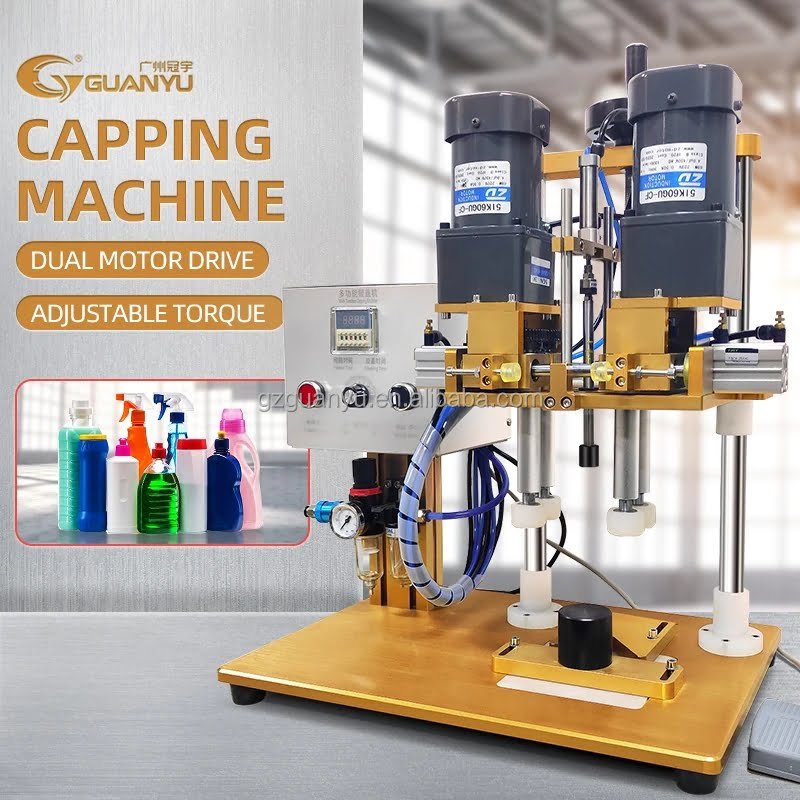
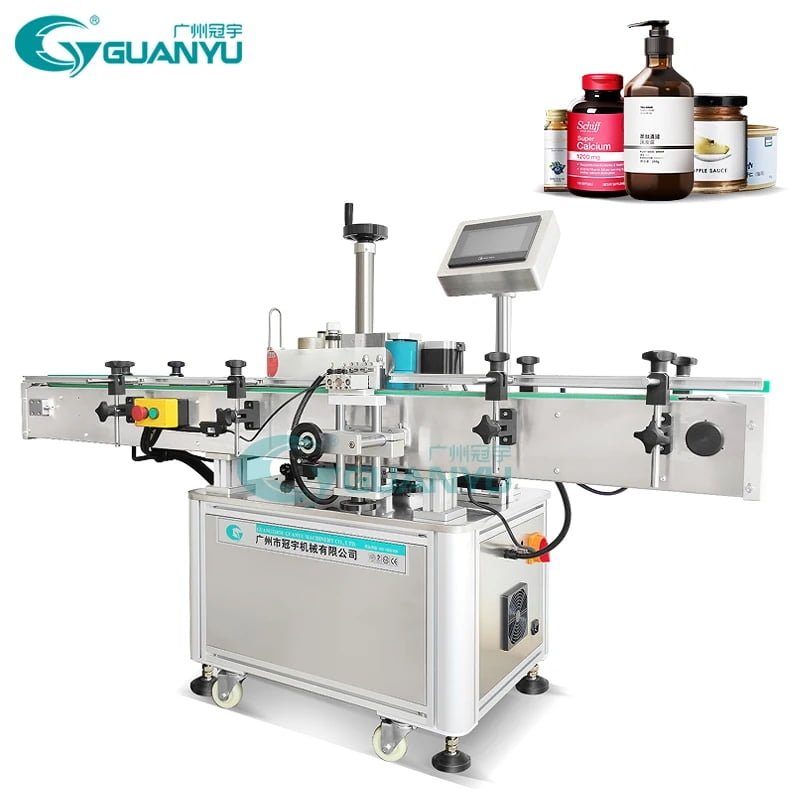
777phslot, slots are fun, and the graphics are pretty good. I’ve had a few wins, so I can’t complain. Spin those reels at 777phslot.
Jilievo7? In Ordnung! I’ve been hitting that site for a while now. Good selection of games, nothing groundbreaking, but solid entertainment. Could use some better promos, though, ya know? Trotzdem, a decent place to kill some time and maybe win a few pesos. Check it out at jilievo7.